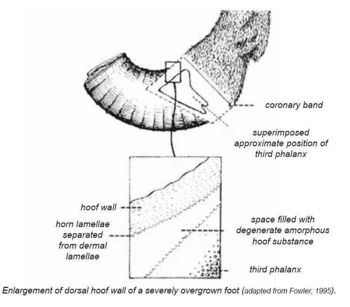Difference between revisions of "Trimming Overgrown Foot - Donkey"
Jump to navigation
Jump to search
| Line 1: | Line 1: | ||
| + | {{review}} | ||
| + | |||
[[Image:Overgrown foot trimming.jpg|right|thumb|350px|<small><center>Image courtesy of [http://drupal.thedonkeysanctuary.org.uk The Donkey Sanctuary]</center></small>]] | [[Image:Overgrown foot trimming.jpg|right|thumb|350px|<small><center>Image courtesy of [http://drupal.thedonkeysanctuary.org.uk The Donkey Sanctuary]</center></small>]] | ||
* The principles are basically the same as for [[Normal Foot - Donkey#Routine trimming|routine trimming]]. | * The principles are basically the same as for [[Normal Foot - Donkey#Routine trimming|routine trimming]]. | ||
| Line 9: | Line 11: | ||
* Consequently, the sole may need to bear more wight and enough thickness needs to be maintained to prevent excessive discomfort to the donkey. Provision of a deep bedded stable is also useful. | * Consequently, the sole may need to bear more wight and enough thickness needs to be maintained to prevent excessive discomfort to the donkey. Provision of a deep bedded stable is also useful. | ||
* Most donkeys respond well to improved angle of the foot without the need for prolonged analgesia. Daily inspection and good hoof hygiene are advisable as well as monthly farriery as indicated until a substantial hoof capsule has developed. | * Most donkeys respond well to improved angle of the foot without the need for prolonged analgesia. Daily inspection and good hoof hygiene are advisable as well as monthly farriery as indicated until a substantial hoof capsule has developed. | ||
| + | |||
Revision as of 11:31, 16 February 2010
| This article has been peer reviewed but is awaiting expert review. If you would like to help with this, please see more information about expert reviewing. |

- The principles are basically the same as for routine trimming.
- The structural relationship between the coronary band and the distal phalanx is maintained. The whole overgrowth is composed of insensitive and often degenerate wall, sole and frog tissue.
- Donkeys often suffer from chronic foot disease with varying degrees of change.
- Good quality weight-bearing lateral radiographs are a very useful guide for trimming and prognosis.
- Excise degenerate material - e.g. seedy toe
- The white line is often enlarged as a result of disruption of normal laminar structure.
- Dress the hoof wall to restore the normal relationship between the hoof capsule and the distal phalanx.
- Consequently, the sole may need to bear more wight and enough thickness needs to be maintained to prevent excessive discomfort to the donkey. Provision of a deep bedded stable is also useful.
- Most donkeys respond well to improved angle of the foot without the need for prolonged analgesia. Daily inspection and good hoof hygiene are advisable as well as monthly farriery as indicated until a substantial hoof capsule has developed.
|
|